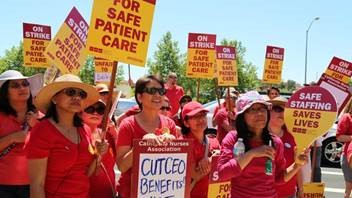
Collective Bargaining
 Understanding Collective Bargaining
Understanding Collective Bargaining
If the nurses at one of our hospitals were to elect the NNOC as their collective bargaining representative then the hospital would “bargain in good faith” with the union in an effort to reach a collective bargaining agreement.
However, this does not mean that employees would automatically receive more (i.e., wages, benefits, etc.) of anything.
In fact, any changes to wages, benefits or other conditions of employment would only come as a result of the collective bargaining process.
How the Process of Collective Bargaining Works
Collective bargaining can be a lot like gambling, because it is an uncertain process in which the outcome is impossible to predict.
During collective bargaining, union representatives make demands and management is free to make counter-proposals. And, while both the union and management must “bargain in good faith,” the NLRB has been clear about what this obligation means:
“These obligations are imposed equally on the employer and the representative of its employees. . . . The obligation does not, however, compel either party to agree to a proposal by the other, nor does it require either party to make a concession to the other.”
Basic Guide to the National Labor Relations Act, p. 12
As the above quote from the NLRB’s Basic Guide to the National Labor Relations Act points out, while a union is free to make any demand they want to during bargaining (i.e., for higher pay, more benefits, a lighter work load, etc.), nothing in the law compels management to agree to any specific union demand.
It Is Possible for Employees to End Up With Less
Collective bargaining is a process of give-and-take, in which each side negotiates against the other to get the best deal possible for themselves. And, it is possible during this back-and-forth trading of proposals and counter-proposals that employees can actually lose (i.e., wages, benefits, other terms and conditions of employment). In collective bargaining, what you have and enjoy now is subject to the negotiation process.
The truth is, as a result of collective bargaining, it is possible for employees to end up with more than they had before unionization. But, it is also possible for employees to end up with the same things they had – or even less than they had – before unionization and collective bargaining.
The NLRB and the courts have been clear in pointing out the uncertainties associated with collective bargaining, as the following excerpt from NLRB case law illustrates:
“The United States Government and the NLRB do not guarantee employees that the collective bargaining process starts from where you presently are in wages, insurance, pensions…and all other conditions of employment…nor did the government guarantee that you will lose no benefits….”
Automation and Measurement Division, Bendix Corp.,
400 F. 2d 141 (1968), US Court of Appeals
Collective Bargaining Means Collective Treatment
It is also important to understand how electing a union may impact flexibility in your work area and your ability to work with your supervisor or manager to find creative solutions to problems.
When a group of employees elects a union, the union becomes the legally certified collective bargaining representative for all of the employees in the defined bargaining unit.
Once this happens, as the NLRB has pointed out (below), it then becomes illegal for an employer to “bargain” with individual employees.
"Once a collective bargaining representative has been designated or selected by its employees, it is illegal for an employer to bargain with individual employees, with a group of employees, or with another employee representative.”
Basic Guide to the National Labor Relations Act, p. 13
So if the union is able to negotiate a contract with management – for good or bad – that contract language would apply to everyone in the bargaining unit…with no exceptions.
NNU/NNOC Collective Bargaining Agreements
View an example of a Collective Bargaining Agreement negotiated by the NNU/NNOC. Please make sure you look at the Management Rights Clause. You may also want to look at the Union Security Clause and Dues Check Off Clause in this contract.
What Happens When the Process Breaks Down?
 The process of collective bargaining is one that can be based on conflict and the notion that when bargaining breaks down, each party is allowed to inflict hardship (i.e. strikes, lockouts, etc.) on the other party as a means to force an agreement.
The process of collective bargaining is one that can be based on conflict and the notion that when bargaining breaks down, each party is allowed to inflict hardship (i.e. strikes, lockouts, etc.) on the other party as a means to force an agreement.
If a union makes demands that management is unwilling or unable to accept, a union may call members out on strike in an attempt to coerce management to agree to its demands.
A strike against a health care organization can be very disruptive for patients, the community and employees (regardless of whether employees decide to strike or cross the picket line).
For striking employees, the decision to strike is not only an emotional one, but also has considerable financial implications. Employees who engage in an economic strike:
- Receive no pay from their employer;
- Risk the loss of employer contributions toward benefits such as medical insurance;
- Are not eligible for unemployment compensation;
- May be permanently replaced for as long as their replacement wants the job.
This is yet another reason why we strongly prefer a positive employee relations climate, free from the kind of conflict and confusion often found in unionized hospitals.
In addition, hospitals must take proactive steps to ensure that patient care is not compromised during a strike. The hospital is allowed to hire temporary, or even permanent (during an economic strike), replacement staff to ensure that patients continue receiving safe high-quality care during a strike. The use of temporary replacement staff has happened many times in the past when the NNU has called a strike.
Important Information about NNU Strikes
Knowing how many times the NNU and its affiliates have called their members out on strike, how long these strikes normally last, and how their members have been effected by these strikes can help you better understand the risks associated with the collective bargaining process.
Even a short strike has ramifications for nurses and the hospital. Strikes are often well publicized in the media and often involve claims of short staffing or unsafe patient conditions. During strikes and rallies, unions sometimes ask their members to go out and tell the community that the hospital doesn’t provide safe or quality patient care. Those statements can have ramifications beyond just the bargaining table if patients decide to seek treatment elsewhere.
Here are some examples of what the NNU and NNOC said about SSM Health Saint Louis University Hospital to pressure negotiations in 2016:
On June 29, 2016, the NNU/NNOC leafleted patients and visitors to SSM Health Saint Louis University Hospital telling them: “Unfortunately, we don’t have enough nurses – to answer your call light quickly – to respond to your physical and emotional needs – to answer your questions. . . . The hospital doesn’t have enough nurses scheduled to provide the care you deserve.”
On July 11, 2016, the NNU/NNOC held an informational picket at SSM Health Saint Louis University Hospital. In its press release, the NNU stated: “Nurses have documented hundreds of examples of understaffing . . .”
NNU Strikes Per Year
The chart below shows how many times NNU/NNOC or its related union, the California Nurses Association have called employees out on strike since 1990 as compared to some state nurse associations.
.png)